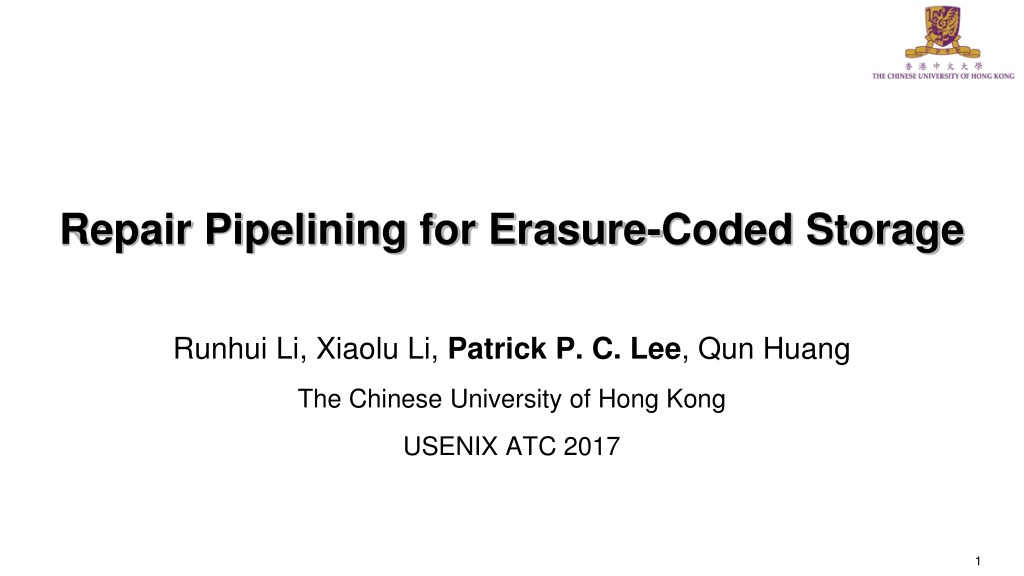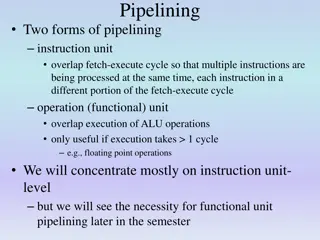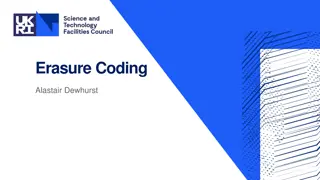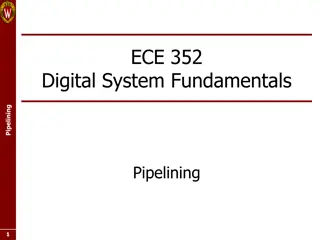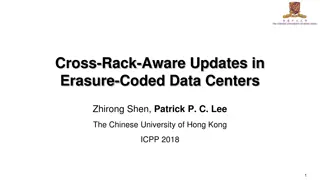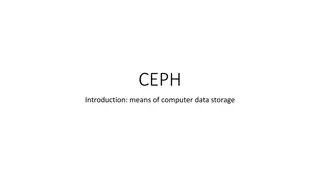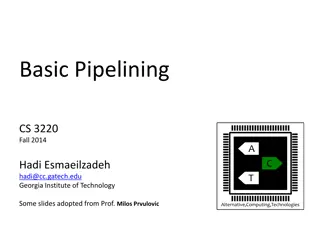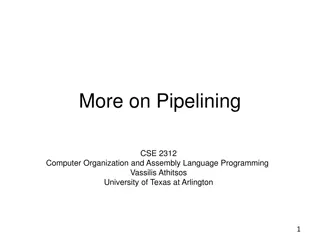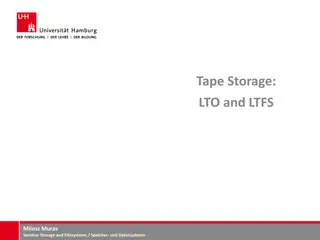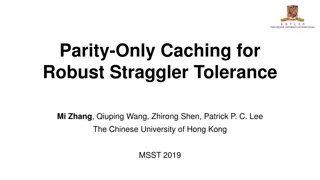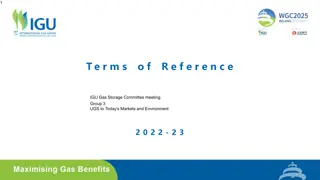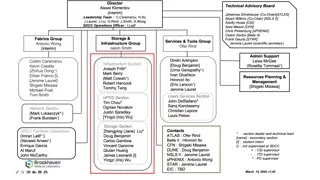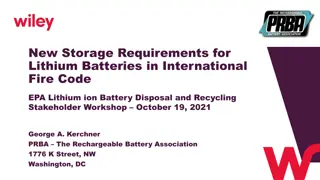Enhancing Erasure-Coded Storage with Repair Pipelining
Erasure coding is a powerful redundancy technique for distributed storage systems, offering fault tolerance and reduced redundancy compared to replication. This paper discusses the concept of erasure coding, its practical applications, and challenges such as repair penalties. It explores innovative approaches like Repair Pipelining to optimize the repair process and improve system efficiency.
Download Presentation

Please find below an Image/Link to download the presentation.
The content on the website is provided AS IS for your information and personal use only. It may not be sold, licensed, or shared on other websites without obtaining consent from the author. Download presentation by click this link. If you encounter any issues during the download, it is possible that the publisher has removed the file from their server.
E N D
Presentation Transcript
Repair Pipelining for Erasure-Coded Storage Runhui Li, Xiaolu Li, Patrick P. C. Lee, Qun Huang The Chinese University of Hong Kong USENIX ATC 2017 1
Introduction Fault tolerance for distributed storage is critical Availability: data remains accessible under failures Durability: no data loss even under failures Erasure coding is a promising redundancy technique Minimum data redundancy via data encoding Higher reliability with same storage redundancy than replication Reportedly deployed in Google, Azure, Facebook e.g., Azure reduces redundancy from 3x (replication) to 1.33x (erasure coding) PBs saving 2
Erasure Coding Divide file data to k blocks Encode k (uncoded) blocks to n coded blocks Distribute the set of n coded blocks (stripe) to n nodes Fault-tolerance: any k out of n blocks can recover file data Nodes A B C D A B C D A B C D divide encode File A+C B+D A+D B+C+D A+C B+D A+D B+C+D (n, k) = (4, 2) 3 Remark: for systematic codes, k of n coded blocks are the original k uncoded blocks
Erasure Coding Practical erasure codes satisfy linearity and addition associativity Each block can be expressed as a linear combination of any k blocks in the same stripe, based on Galois Field arithmetic e.g., block B = a1B1 + a2B2 + a3B3 + a4B4 for k = 4, coefficients ai s, and blocks Bi s Also applicable to XOR-based erasure codes Examples: Reed-Solomon codes, regenerating codes, LRC 4
Erasure Coding Good: Low redundancy with high fault tolerance Bad: High repair penalty In general, k blocks retrieved to repair a failed block Mitigating repair penalty of erasure coding is a hot topic New erasure codes to reduce repair bandwidth or I/O e.g., Regenerating codes, LRC, Hitchhiker Efficient repair approaches for general erasure codes e.g., lazy repair, PPR 5
Conventional Repair Single-block repair: Retrieve k blocks from k working nodes (helpers) Store the repaired block at requestor Network Bottleneck N1 N2 N3 N4 R k = 4 helpers requestor Repair time = k timeslots Bottlenecked by requestor s downlink Uneven bandwidth usage (e.g., links among helpers are idle) 6
[Mitra, EuroSys16] Partial-Parallel-Repair (PPR) Exploit linearity and addition associativity to perform repair in a divide-and-conquer manner Timeslot 1: N1 sends a1B1 to N2 N3 sends a3B3 to N4 Timeslot 2: N2 sends a1B1+a2B2 to N4 a1B1+a2B2+a3B3+a4B4 Timeslot 3: N4 R repaired block a1B1+a2B2 a3B3+a4B4 Network N1 N2 N3 N4 R k = 4 helpers requestor Repair time = ceil(log2(k+1)) timeslots 7
Open Question Repair time of erasure coding remains larger than normal read time Repair-optimal erasure codes still read more data than amount of failed data Erasure coding is mainly for warm/cold data Repair penalty only applies to less frequently accessed data Hot data remains replicated Can we reduce repair time of erasure coding to almost the same as the normal read time? Create opportunity for storing hot data with erasure coding 8
Our Contributions Repair pipelining, a technique to speed up repair for general erasure coding Applicable for degraded reads and full-node recovery O(1) repair time in homogeneous settings Extensions to heterogeneous settings A prototype ECPipe integrated with HDFS and QFS Experiments on local cluster and Amazon EC2 Reduction of repair time by 90% and 80% over conventional repair and partial-parallel-repair (PPR), respectively 9
Repair Pipelining Goals: Eliminate bottlenecked links Effectively utilize available bandwidth resources in repair Key observation: coding unit (word) is much smaller than read/write unit (block) e.g., word size ~ 1 byte; block size ~ 64 MiB Words at the same offset are encoded together in erasure coding words at the same offset are encoded together word n blocks of a stripe 10
Repair Pipelining Idea: slicing a block Each slice comprises multiple words (e.g., slice size ~ 32 KiB) Pipeline the repair of each slice through a linear path Single-block repair: a1b1+a2b2 +a3b3 a1b1+a2b2 +a3b3+a4b4 a1b1 a1b1+a2b2 k = 4 s = 6 slices N1 N2 N3 N4 R N1 N2 N3 N4 R N1 N2 N3 N4 R N1 N2 N3 N4 R N1 N2 N3 N4 R N1 N2 N3 N4 R time Repair time = 1 + (k-1)/s 1 timeslot if s is large 11
Repair Pipelining Two types of single-failure repair (most common case): Degraded read Repairing an unavailable block at a client Full-node recovery Repairing all lost blocks of a failed node at one or multiple nodes Greedy scheduling of multiple stripes across helpers Challenge: repair degraded by stragglers Any repair of erasure coding faces similar problems due to data retrievals from multiple helpers Our approach: address heterogeneity and bypass stragglers 12
Extension to Heterogeneity Heterogeneity: link bandwidths are different Case 1: limited bandwidth when a client issues reads to a remote storage system Cyclic version of repair pipelining: allow a client to issue parallel reads from multiple helpers Case 2: arbitrary link bandwidths Weighted path selection: select the best path of helpers for repair 13
Repair Pipelining (Cyclic Version) N1 N2 N3 N4 Send to requestor R N2 N3 N4 N1 N3 N4 N4 N1 N1 N2 N2 Group 1 N1 N2 N3 N4 Send to requestor R N2 N3 N4 N1 N3 N4 N4 N1 N1 N2 N2 Group 2 Requestor receives repaired data from k-1 helpers Repair time in homogeneous environments 1 timeslot for large s 14
Weighted Path Selection Goal: Find a path of k + 1 nodes (i.e., k helpers and requestor) that minimizes the maximum link weight e.g., set link weight as inverse of link bandwidth Any straggler is associated with large weight Brute-force search is expensive (n-1)!/(n-1-k)! permutations Our algorithm: Apply brute-force search, but avoid search of non-optimal paths If link L has weight larger than the max weight of the current optimal path, any path containing L must be non-optimal Remain optimal, with much less search time 15
Implementation ECPipe: a middleware atop distributed storage system Coordinator Requestor control flow Helper Helper Helper datal flow Node Node Node Requestor implemented as a C++/Java class Each helper daemon directly reads local blocks via native FS Coordinator access block locations and block-to-stripe mappings ECPipe is integrated with HDFS and QFS, with around 110 and 180 LOC of changes, respectively 16
Evaluation ECPipe performance on a 1Gb/s local cluster Trade-off of slice size: Too small: transmission overhead is significant Too large: less parallelization Best slice size = 32 KiB Repair pipelining (basic and cyclic) outperforms conventional and PPR by 90.9% and 80.4%, resp. Only 7% more than direct send time over a 1Gb/s link O(1) repair time Single-block repair time vs. slice size for (n,k) = (14,10) 17
Evaluation ECPipe performance on a 1Gb/s local cluster Recovery rate increases with number of requestors Repair pipelining (RP and RP+scheduling) achieves high recovery rate Greedy scheduling balances repair load across helpers when there are more requestors (i.e., more resource contention) Full-node recovery rate vs. number of requestors for (n,k) = (14,10) 18
Evaluation ECPipe performance on Amazon EC2 Weighted path selection reduces single-block repair time of basic repair pipelining by up to 45% 19
Evaluation Single-block repair performance on HDFS and QFS QFS: slice size QFS: block size HDFS: (n,k) ECPipe significantly improves repair performance Conventional repair under ECPipe outperforms original conventional repair inside distributed file systems (by ~20%) Avoid fetching blocks via distributed storage system routine Performance gain is mainly due to repair pipelining (by ~90%) 20
Conclusions Repair pipelining, a general technique that enables very fast repair for erasure-coded storage Contributions: Designs for both degraded reads and full-node recovery Extensions to heterogeneity Prototype implementation ECPipe Extensive experiments on local cluster and Amazon EC2 Source code: http://adslab.cse.cuhk.edu.hk/software/ecpipe 21
